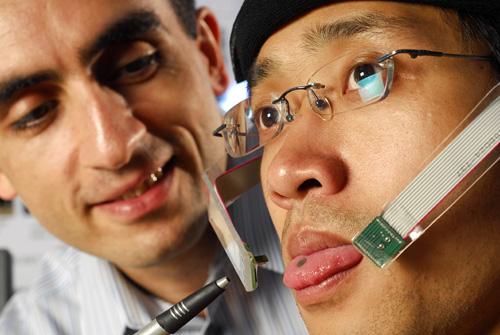New tongue talent beats tying cherry stems

August 25, 2008
ATLANTA – The tireless tongue already controls taste and speech, helps kiss and swallow and fights germs. Now scientists hope to add one more ability to the mouthy muscle, and turn it into a computer control pad.
Georgia Tech researchers believe a magnetic, tongue-powered system could transform a disabled person’s mouth into a virtual computer.
“You could have full control over your environment by just being able to move your tongue,” said Maysam Ghovanloo, a Georgia Tech assistant professor who leads the team’s research.
The group’s Tongue Drive System turns the tongue into a joystick of sorts, allowing the disabled to manipulate wheelchairs, manage home appliances and control computers. The work still has a ways to go – one potential user called the design “grotesque” – but early tests are encouraging.
Ghovanloo’s work centers on creating a virtual keyboard instead of a physical one. He does that through a magnet about 3 millimeters wide that’s placed under the tip of the tongue.
Get The Daily Illini in your inbox!
The magnet’s movement is tracked by sensors on the side of each cheek, which sends data to a receiver atop a rather bulky set of headgear. It is then processed by software that converts the movement into commands for a wheelchair or other electronics.
It’s an impressive display, and Ghovanloo said he hopes he could one day add dozens more commands that turn teeth into keyboards and cheeks into computer consoles. For example, “Left-up could be turning lights on, right-down could be turning off the TV,” Ghovanloo said.
But plenty of challenges await. Researchers must pare down the bulky headgear into a dental retainer. The team also must improve the software, tinker with the size of the magnet and boost the wireless battery’s charge.
Above all, they must find a way to keep costs in between the “sip and puff” systems, which can cost hundreds of dollars, to more sophisticated eye-tracking systems, which cost thousands.






